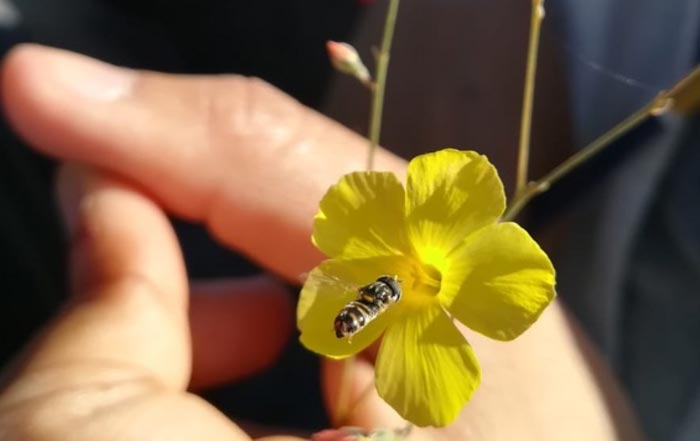The long and short of a supergene for efficient pollination

Pollinator visiting Linum tenue. Photo: Juanita Gutiérrez-Valencia
Credit: Juanita Gutiérrez-Valencia
Scientists have solved the century-old mystery of a supergene that causes efficient cross-pollination in flowers. The results show that sequence length variation at the DNA level is important for the evolution of two forms of flowers that differ in the length of their sexual organs. The study is published today in Current Biology.
Gardeners and botanists have known since the 1500s that some plant species have two forms of flowers that differ reciprocally in the length of their male and female sexual organs. Darwin first proposed that such distylous flowers promoted efficient cross-pollination by insect pollinators. Early geneticists showed that the two forms of flowers were controlled by a single chromosomal region likely harboring a cluster of genes, a supergene. But until recently this supergene had never been sequenced.
Now, researchers at Stockholm University, together with partners at Uppsala University, Durham University, University of Granada, and University of Seville, have solved the mystery of the supergene. They studied a system where already Darwin described distyly, wild flaxseed species, Linum, and used modern DNA sequencing methods to identify the supergene.
Surprisingly, they found that the supergene responsible for differing lengths of male and female sexual organs itself varied in length. Specifically, the dominant form of the supergene contained about 260 000 base pairs of DNA that were missing from the recessive form. The 260 000 base pair stretch of DNA harbored several genes likely to cause length variation in sexual organs.
”These results were really surprising to us, because a similar genetic makeup of the supergene that governs distyly has previously been identified in another system, primroses, where it evolved completely independently,” said Tanja Slotte, Professor in Ecological Genomics at Stockholm University and senior author of the study.
”Not only has evolution repeatedly led to similar variation in the flowers of primroses and flaxseed species, it has also relied on a similar genetic solution to achieve this feat,” said Juanita Gutiérrez-Valencia, PhD student at Stockholm University and first author of the study.
These findings provide new insights into the exceptional power of evolution to find convergent solutions to widespread adaptive challenges such as the need for flowering plants to be cross-pollinated.
”Distyly is ultimately a mechanism for efficient cross-pollination. Understanding pollination mechanisms is particularly important today given climate change and challenges faced by both plant and insect pollinator populations,” said Professor Tanja Slotte.
Journal: Current Biology
DOI: 10.1016/j.cub.2022.08.042
Method of Research: Experimental study
Subject of Research: Cells
Article Title: Genomic analyses of the Linum distyly supergene reveal convergent evolution at the molecular level
Article Publication Date: 9-Sep-2022
All latest news from the category: Life Sciences and Chemistry
Articles and reports from the Life Sciences and chemistry area deal with applied and basic research into modern biology, chemistry and human medicine.
Valuable information can be found on a range of life sciences fields including bacteriology, biochemistry, bionics, bioinformatics, biophysics, biotechnology, genetics, geobotany, human biology, marine biology, microbiology, molecular biology, cellular biology, zoology, bioinorganic chemistry, microchemistry and environmental chemistry.
Newest articles

Innovative 3D printed scaffolds offer new hope for bone healing
Researchers at the Institute for Bioengineering of Catalonia have developed novel 3D printed PLA-CaP scaffolds that promote blood vessel formation, ensuring better healing and regeneration of bone tissue. Bone is…

The surprising role of gut infection in Alzheimer’s disease
ASU- and Banner Alzheimer’s Institute-led study implicates link between a common virus and the disease, which travels from the gut to the brain and may be a target for antiviral…

Molecular gardening: New enzymes discovered for protein modification pruning
How deubiquitinases USP53 and USP54 cleave long polyubiquitin chains and how the former is linked to liver disease in children. Deubiquitinases (DUBs) are enzymes used by cells to trim protein…



